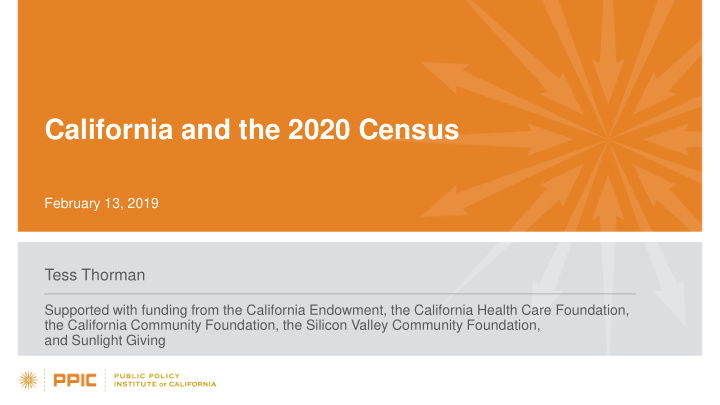



California and the 2020 Census February 13, 2019 Tess Thorman Supported with funding from the California Endowment, the California Health Care Foundation, the California Community Foundation, the Silicon Valley Community Foundation, and Sunlight Giving
PPIC’s goal is to increase knowledge and awareness about the importance of the 2020 Census Provide a steady stream of trusted, nonpartisan information Engage diverse audiences, including policymakers, philanthropy, business leaders, community leaders, the media Offer opportunities for dialogue and inspire collaborative responses to the challenge of the 2020 Census Support for a two-year effort comes from a coalition of funders
PPIC is producing a wide array of products, events Fact sheets and in-depth reports Blog posts, including a series on hard-to-count communities Videos in English and Spanish Events – March 25 in Sacramento with Secretary of State Padilla – Numerous regional events For more detail, visit https://www.ppic.org/topics/trending-2020-census/
An accurate count is critical for California Nearly a quarter of the state’s spending comes from federal funding tied to census statistics An undercount of Californians could cost a seat in Congress Undercounting hard-to-count populations could shift representation away from communities of color The state is increasingly hard to count
Substantial state funding will go toward reaching hard-to-count (HTC) communities $90.3 million in 2018-19; $50 million proposed for 2019-20 County and tribal governments opt-in to preset amounts – Based on number in HTC tracts (counties) or housing units (tribes) – Population-based minimum amount Community-based organizations apply for contracts – Regional totals based on share of state’s HTC population – Statewide CBOs target specific populations Paid media apply for contracts
PPIC’s interactive maps can help funders complement state and local efforts Where do members of the hard-to- count community I want to reach generally live? What factors make the geographic community I want to reach hard to count?
PPIC’s interactive maps can help funders complement state and local efforts Where do members of the hard-to- count community I want to reach generally live? What factors make the geographic community I want to reach hard to count?
PPIC’s interactive maps can help funders complement state and local efforts Where do members of the hard-to- count community I want to reach generally live? What factors make the geographic community I want to reach hard to count?
The San Joaquin Valley is likely to be hard to count in many ways Relative to the rest of the state, higher population shares of – Children under 5 – Historically undercounted racial/ethnic groups – Noncitizens High share of housing is nonstandard Rural areas have low internet access
Imperial County presents similar challenges Relative to the rest of the state, higher shares of – Children under 5 – Historically undercounted racial/ethnic groups – Noncitizens High share of housing is nonstandard Less likely to have internet access at home
The Far North has different issues Hard-to-count communities distributed throughout Widespread lack of internet access Overall, lower population shares of – Young children – Historically undercounted racial/ethnic groups – Noncitizens Less nonstandard housing
The San Francisco Bay Area has hard-to-count communities throughout Overall, higher population shares of noncitizens The East Bay has higher shares of – Young children – Historically undercounted racial/ethnic groups And more nonstandard housing
Evidence-based outreach is essential Census Bureau and California groups have conducted research on messaging – 2020 Census Barriers, Attitudes, and Motivators Study – Census Outreach project by CommunityConnect Labs But effective outreach will require more than good messaging – Small undercounts throughout the process could have a large effect – Outreach efforts will need to account for the many reasons why communities might be hard to count
Notes on the use of these slides These slides were created to accompany a presentation. They do not include full documentation of sources, data samples, methods, and interpretations. To avoid misinterpretations, please contact: Tess Thorman (thorman@ppic.org; 415-291-4449) Thank you for your interest in this work.
Recommend
More recommend